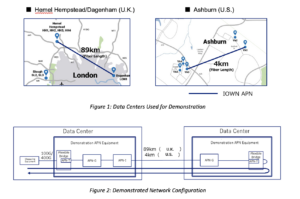Insider Brief
- NTT Corporation and NTT DATA announced the successful demonstration of All-Photonics Network (APN)-driven hyper low-latency connections between data centers in the United States and United Kingdom.
- The goal of this initiative is to transform geographically distributed IT infrastructure into the functional equivalent of a single data center.
- The announcement was made at Upgrade 2024.
PRESS RELEASE — At Upgrade 2024, NTT Corporation (NTT) and NTT DATA announced the successful demonstration of All-Photonics Network (APN)-driven hyper low-latency connections between data centers in the United States and United Kingdom. In the U.K., NTT connected data centers north and east of London via NTT’s Innovative Optical Wireless Network (IOWN) APN, and communication between them was realized with a round-trip delay of less than 1 millisecond. In the U.S., data centers in Northern Virginia achieved similar results. The goal of this initiative is to transform geographically distributed IT infrastructure into the functional equivalent of a single data center.

The data center market is under severe local constraints. Carbon dioxide emission restrictions and land shortages have made it difficult to build data centers in urban areas, forcing operators to turn to the suburbs. Yet with geographically distant data centers, delay of communication, or latency, can be very high, making it difficult to meet customers’ needs for low latency. In separate demonstrations, NTT and NTT DATA connected data centers in the U.K. (HH2 in Hemel Hempstead and LON1 in Dagenham) and in the U.S. (VA1 and VA3 in Ashburn) using APN equipment from NEC. These U.K. and U.S. data centers are 89km and 4km apart, respectively. (See Figure 1.) Measurements in tests conducted over 100 Gbps and 400 Gbps links showed the two APN-connected data centers in the U.K. operated with less than 1 millisecond (approximately 0.9 milliseconds) of latency, and with a delay variation (sometimes called jitter) of less than 0.1 microseconds. (See Figure 2 and Table 1.)

According to cloud connectivity provider Megaport, typical delay between data centers at an equivalent distance exceeds 2,000 microseconds (2 milliseconds). In the U.S. case, delay over the much shorter span was approximately 0.06 milliseconds; and delay variation was less than 0.05 microseconds. By contrast, conventional networks with general Layer 2 switches experience delay variation of several microseconds to tens of microseconds. In other words, the APN cuts latency in half, and jitter by orders of magnitude.
The APN delivered very low latency required by current and emerging use cases. These include distributed, real-time AI analysis, such as industrial IoT and predictive maintenance, smart surveillance systems, smart grid and energy management, natural disaster detection and response and more. NTT DATA is also conducting demonstrations in the financial sector, where low latency is required for remittances, settlements and transactions. Another advantage of the IOWN APN is that it enables line activation simply by adding wavelengths, without needing to install new dark fiber. As a result, data center operators can respond very quickly to customer demand.
If you found this article to be informative, you can explore more current quantum news here, exclusives, interviews, and podcasts.


















